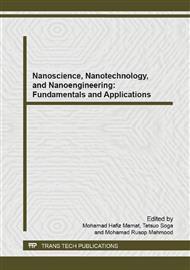p.390
p.395
p.401
p.405
p.410
p.415
p.419
p.424
p.429
Concept and Design of SOI Nanogap Based on Capacitive Sensor for Escherichia coli O157:H7 Detection
Abstract:
Early warning detection method for food-borne pathogen Escherichia coli (E.coli) especially a harmful serotype O157:H7 has become an important public health issue in food industrial due to its frequent outbreak around the world. Serotype O157:H7 E.coli is an enterhemorrhagic virulence group of E.coli that can be found in contaminated food such as raw meat, unpasteurized milk, raw tomatoes, cucumber, and leafy salad or in animal and media which spread the pathogen. Consumption of a small amount of O157:H7 E.coli within 10 to 24 hours can caused severe illness such as diarrhea, nausea, vomiting, fever, headache and muscular pain. Therefore, there is a need for higher sensitivity and selectivity and rapid method to detect the deadly pathogen in early stage and to prevent the spread and infection to human. Nanogap based biosensor has become an emerging advance method for detecting a nanometer size biomolecules that cannot be seen to the human eyes. Nanogap is a combination of two electrodes with nanometer gap. The novelty of nanogap is its ability to detect a small amount of biomolecules that trap between the gaps by observing their electrical properties changes. In this paper, we present a concept and design of SOI nanogap based capacitance sensor for O157:H7 E.coli detection using AutoCAD software.
Info:
Periodical:
Pages:
410-414
Citation:
Online since:
June 2015
Authors:
Keywords:
Price:
Сopyright:
© 2015 Trans Tech Publications Ltd. All Rights Reserved
Share:
Citation:


